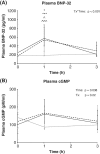Cardiorenal and endocrine effects of synthetic canine BNP1-32 in dogs with compensated congestive heart failure caused by myxomatous mitral valve disease
- PMID: 30703246
- PMCID: PMC6430907
- DOI: 10.1111/jvim.15416
Cardiorenal and endocrine effects of synthetic canine BNP1-32 in dogs with compensated congestive heart failure caused by myxomatous mitral valve disease
Abstract
Background: The effects of synthetic brain natriuretic peptide (BNP1-32) on cardiorenal and renin angiotensin aldosterone system in dogs with naturally occurring congestive heart failure (CHF) are unknown.
Objectives: To evaluate the cardiorenal and endocrine effects of SC administered synthetic canine BNP1-32, with or without furosemide, in dogs with CHF caused by myxomatous mitral valve disease (MMVD).
Animals: Seven client-owned male dogs with compensated American College of Veterinary Internal Medicine stage C CHF caused by MMVD on chronic treatment with furosemide, benazepril, and pimobendan.
Methods: A single-dose, crossover, pilot study. Each dog received a dose of BNP1-32 (5 μg/kg), furosemide (2 mg/kg), and both BNP1-32/furosemide (5 μg/kg and 2 mg/kg, respectively) SC with a 2-week washout period among each treatment. Between- and within-treatment effects were evaluated using linear mixed modeling with restricted maximum likelihood estimation and evaluation of least square differences.
Results: Rapid absorption of BNP1-32 and a corresponding rise in urinary cyclic guanosine monophosphate excretion was observed at 1-2 hours after any treatment containing BNP1-32 (P < .05). However, BNP1-32 did not influence measured cardiorenal variables. Plasma aldosterone concentrations were below quantifiable levels in majority of the samples.
Conclusions and clinical importance: No beneficial cardiorenal effects were detected. It is possible that dogs with chronic CHF have a reduction in natriuretic peptide responsiveness.
Keywords: RAAS; aldosterone; brain natriuretic peptide; cGMP; canine.
© 2019 The Authors. Journal of Veterinary Internal Medicine published by Wiley Periodicals, Inc. on behalf of the American College of Veterinary Internal Medicine.
Conflict of interest statement
Authors declare no conflict of interest.
Figures





Similar articles
-
Short-term hemodynamic and neuroendocrine effects of pimobendan and benazapril in dogs with myxomatous mitral valve disease and congestive heart failure.J Vet Intern Med. 2013 Nov-Dec;27(6):1452-62. doi: 10.1111/jvim.12217. Epub 2013 Oct 15. J Vet Intern Med. 2013. PMID: 24128373 Clinical Trial.
-
Aldosterone breakthrough in dogs with naturally occurring myxomatous mitral valve disease.J Vet Cardiol. 2017 Jun;19(3):218-227. doi: 10.1016/j.jvc.2017.03.001. Epub 2017 May 31. J Vet Cardiol. 2017. PMID: 28576479
-
Effect of pimobendan or benazepril hydrochloride on survival times in dogs with congestive heart failure caused by naturally occurring myxomatous mitral valve disease: the QUEST study.J Vet Intern Med. 2008 Sep-Oct;22(5):1124-35. doi: 10.1111/j.1939-1676.2008.0150.x. Epub 2008 Jul 11. J Vet Intern Med. 2008. PMID: 18638016 Clinical Trial.
-
An update on treatment and prognostic indicators in canine myxomatous mitral valve disease.J Small Anim Pract. 2009 Sep;50 Suppl 1:25-33. doi: 10.1111/j.1748-5827.2009.00800.x. J Small Anim Pract. 2009. PMID: 19765217 Review.
-
Diagnosis and management of a more advanced stage of preclinical myxomatous mitral valve disease in dogs without echocardiography.Schweiz Arch Tierheilkd. 2024 Dec;166(12):619-631. doi: 10.17236/sat00438. Schweiz Arch Tierheilkd. 2024. PMID: 39623872 Review. English.
Cited by
-
Management of Chronic Congestive Heart Failure Caused by Myxomatous Mitral Valve Disease in Dogs: A Narrative Review from 1970 to 2020.Animals (Basel). 2022 Jan 16;12(2):209. doi: 10.3390/ani12020209. Animals (Basel). 2022. PMID: 35049831 Free PMC article. Review.
References
-
- Borgarelli M, Buchanan JW. Historical review, epidemiology and natural history of degenerative mitral valve disease. J Vet Cardiol. 2012;14:93‐101. - PubMed
-
- Atkins CE, Bonagura JD, Ettinger SJ, et al. Guidelines for the diagnosis and treatment of canine chronic valvular heart disease. J Vet Intern Med. 2009;23:1142‐1150. - PubMed
-
- Häggström J, Boswood A, O'Grady MR, et al. Effect of pimobendan or benazepril hydrochloride on survival times in dogs with congestive heart failure caused by naturally occurring myxomatous mitral valve disease: the QUEST study. J Vet Intern Med. 2008;22:1124‐1135. - PubMed
-
- Lombard CW, Jöns O, Bussadori CM. Clinical efficacy of pimobendan versus benazepril for the treatment of acquired atrioventricular valvular disease in dogs. J Am Anim Hosp Assoc. 2006;42:249‐261. - PubMed
MeSH terms
Substances
Grants and funding
LinkOut - more resources
Full Text Sources
Medical

